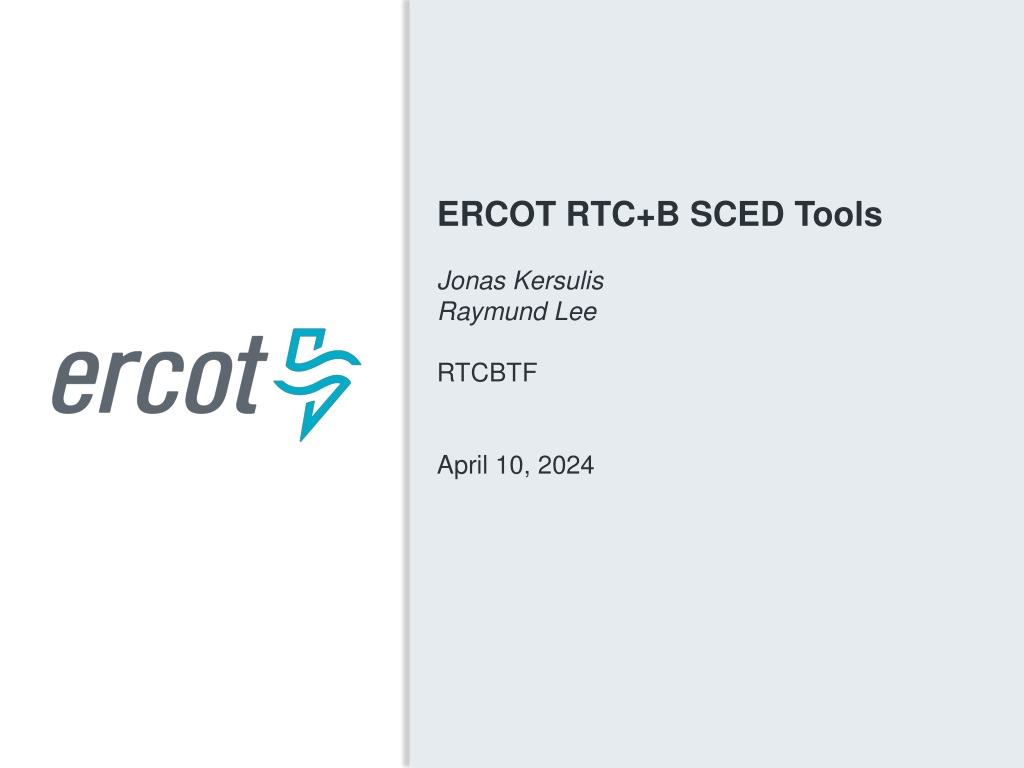

Replay
0 likes | 19 Views
ERCOT has developed two different Real-Time Co-optimization (RTC) simulator tools - a small-scale Excel tool and a production-scale Python tool. The presentation outlines the capabilities, inputs, outputs, and limitations of these tools, along with a demonstration of the small-scale tool and an overview of the production-scale tool's optimization system data. The tools aim to simulate and analyze RTC pricing outcomes relative to outcomes under the Operating Reserve Demand Curve (ORDC). ERCOT is seeking feedback on the framework and progress of these tools.

E N D
ERCOT RTC+B SCED Tools Jonas Kersulis Raymund Lee RTCBTF April 10, 2024
Outline - Introduction - Motivation and purpose - Two RTC simulator tools for two different needs - Demonstration of small-scale Excel Simulator Tool - Overview of Production-scale Python Simulator Tool - Inputs and outputs - Capabilities and formulation (Current and Future) - Limitations 2 2 Public
Introduction - KP1.1 (8) - ERCOT will work with stakeholders prior to RTC go-live to develop a framework and reporting to periodically review RTC pricing outcomes relative to pricing outcomes that would have been realized through the ORDC for a reasonable period of time. The purpose of this presentation is to describe the capabilities and progress of two ERCOT-developed RTC simulator tools. - Comparing The Characteristics of Two RTC Simulator Tools Small-Scale Production-Scale Excel Python Platform Small 5-generator case, fixed topology, modifiable parameters Production Imitation of future implementation of RTC Scale Educational Simple scenarios to illustrate RTC characteristics and behavior Analytical Perform “what-if” analysis Validate and test future production RTC results Use Case Completed In progress Status 3 3 Public
Demonstration of Small-scale Tool This simple scenario illustrates how co-optimization can impact AS allocation and congestion management. – 5 online generators with different Energy price points – 4 generators each offer 20 MW of RRS @ $20/MWh – Increase RRS procurement amount from 0 MW to 50 MW, in increments of 10 MW. • Question: How will RTC allocate RRS after each increment? • Answer: RTC allocates RRS to resources with the highest priced energy offers. – Decrease transmission constraint L6 limit to 75 MW • Question: How will RTC manage the transmission constraint? • Answer: RTC re-dispatched energy and allocated RRS to the other side of the constraint. • Initial input parameters 4 4 Public
Overview of Production-scale Tool Core Outputs Inputs Optimization System Data • GTBD • AS Plan • ASDC parameters • MCL, VOLL System Outputs • System Lambda • Objective Function Build and solve optimization problem Resource Outputs • LMPs • Energy Awards • AS MCPCs • AS Awards Resource Data • Status • Resource Type • Capacity and Ramping Limits • AS Capability and Qualification • Energy and AS Offers Transmission Outputs • Constraint loading • Constraint shadow price Transmission Constraints (Details on next slide) Shift Factors 5 5 Public
Optimization Details Decision Variables • Base points • AS awards • ASDC variables • Transmission slack variables • Power balance slack variables • Binary variables • Carrying NFRC • ESR Charge/Discharge Constraints • Power balance • Total AS award MW = Cleared ASDC MW • Generator limits • Capacity Limits (LSL, HSL) • Ramp Limits (LDL, HDL) • Max AS award (based on qualification, status, ramp capability, overrides) • Linked AS Offers • Transmission Constraints • System-wide RRS procurement • Regulation Ramping Constraint • NFRC Conditional Constraint • SOC Conditional Constraints Objective Minimize total system cost: • Energy award costs • AS award costs minus ASDC benefit • Transmission and overgen/undergen penalties Implemented In progress 6 6 Public
Capabilities and Limitations Non-sequential multi-interval analysis comparing simulated vs actual system lambda Current Functionality - Replicate results of Excel Tool - Solve production-scale cases derived from historical SCED data - Perform non-sequential multi- interval simulation Planned Functionality - Pricing run - ESR single model - Improved output data visualization - Sequential multi-interval simulation - Mitigation *Results shown illustrate the tool’s current capability and do not necessarily reflect production RTC outcomes. Limitations - Market submission assumptions - Internal tool (ERCOT database access required) 7 7 Public
Summary and Next Steps 1) 2) ERCOT wanted to share the details of the framework being developed ERCOT is interested in feedback on this framework or Operating Days (to discuss at next RTCBTF) Tool is still under development and will share updates on progress 3) Questions? 8 8 Public